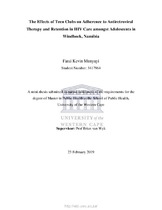| dc.description.abstract | Adolescents living with HIV (ALHIV) are notably underserved by national HIV
programmes globally due to their unique needs. Of particular concern is limited access to
and availability of adolescent-friendly ART services, which contributes to poor ART
adherence and retention in care in many sub-Saharan African countries. Poor adherence
in adolescents has been associated with medicine side effects, pill fatigue, non-disclosure
of status to the child, inadequate information on HIV, caregiver-child communication,
caregiver’s health beliefs and stigma, and lack of knowledge on the rationale of taking
medicines. Several interventions have been developed to improve ART adherence and
retention in care amongst ALHIV through peer groups and psychosocial support.
The Teen Club intervention was introduced in 2010 at Intermediate Hospital Katutura
Paediatric ART clinic in Windhoek to improve ART adherence and retention in care
amongst ALHIV by providing psychosocial support in a group environment. However, to
date no formal evaluation of the effectiveness of the Teen Club intervention in Namibia
has been conducted.
The aim of the study was to compare the effects of the Teen Club intervention against
standard care on treatment outcomes for ART (i.e. adherence, retention in care and viral
suppression) in adolescents at Intermediate Hospital Katutura Paediatric ART clinic in
Namibia.
Methods: A retrospective cohort analysis of HIV positive adolescents aged 10-19 years,
who were accessing ART between 1 July 2015 and 30 June 2017 was conducted. Patient
data was extracted from the electronic Patient Monitoring System (ePMS), individual
Patient Care Booklets and the teen club attendance register. Adherence to ART was
measured through pill counts; and retention by kept clinic visits. Viral load results were
assessed to measure levels of viral suppression. Adolescents with viral loads ≥ 1000
copies/ml were classified as not virally suppressed whilst those with viral loads <1000
are virally suppressed (with those <40 fully suppressed).
Results: The total sample was 385 participants; with 78 of them in the Teen Club
(exposed) and 307 adolescents in standard care (unexposed). | en_US |

